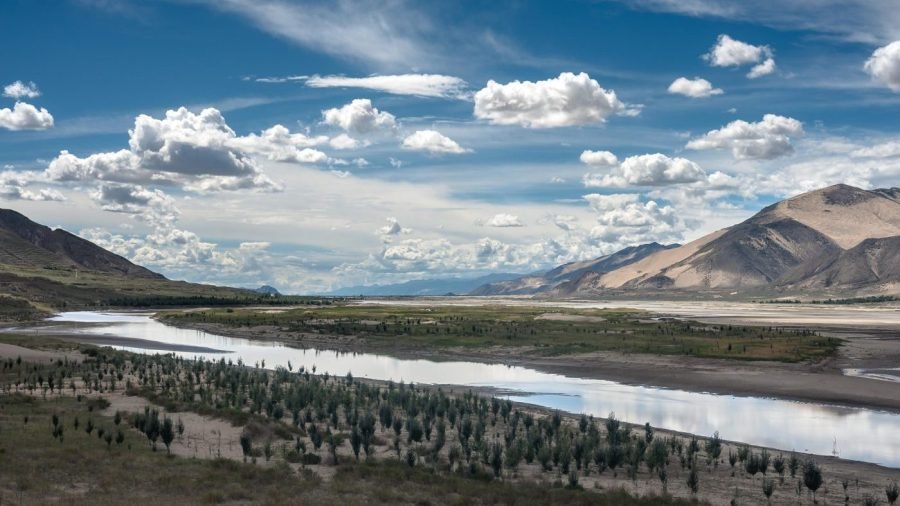
China has built more dams than any other country and more large dams than the rest of the world combined. This month, it officially acknowledged construction of the biggest dam ever conceived in human history — although satellite imagery suggests the groundwork began much earlier, following the megaproject’s approval by China’s rubber-stamp parliament in 2021.
Located on the Brahmaputra River just before it curves into India, this super-dam is being developed with little transparency in a seismically active and ecologically fragile region near the heavily militarized Tibetan-Indian frontier. Once completed, the massive structure will dwarf the Three Gorges Dam on the Yangtze, and is expected to generate nearly three times as much hydropower by harnessing the Brahmaputra’s sharp descent from Himalayan peaks into the world’s deepest canyon.
Yet far beyond electricity production, the project portends a looming geopolitical and environmental crisis. It stands to disrupt the hydrological balance for millions of people downstream, destabilize a delicate Himalayan ecosystem and provide Beijing with a potent new lever over India, its strategic rival.
China appears to have learned nothing from its own cautionary tale: the Three Gorges Dam, currently the world’s largest. Once hailed as an engineering marvel, the dam has become an environmental nightmare — eroding riverbanks and deltas, degrading water quality, triggering frequent landslides and causing lasting ecological damage.
The new super-dam’s site is on a geologic fault line — a recipe for catastrophe. Scientists warn that large dam reservoirs can trigger seismic activity, a phenomenon known as reservoir-triggered seismicity. In this quake-prone region, the tectonic stresses induced by such a megastructure could lead to devastating earthquakes.
The Brahmaputra — the world’s highest-altitude major river — draws its perennial flow from Himalayan springs, glacial melt, upland wetlands and tributaries. The vast majority of these sources lie within Chinese-occupied Tibet, where the river is known as the Yarlung Zangbo. In contrast, India contributes modestly to the river’s year-round volume, though it plays a greater role in its monsoonal surge. After flowing through India’s Arunachal Pradesh and Assam states, the river enters Bangladesh before draining into the Bay of Bengal.
But a river’s flow is not just about water — it also carries nutrient-rich sediment, serving as the ecological lifeblood of entire regions.
By building a gigantic dam just before the river exits Chinese-controlled territory, Beijing gains the power to manipulate cross-border flows, including during the critical dry season. It can withhold or release water at will, trap sediment and potentially weaponize water in future disputes.
By capturing silt-laden waters before they reach India and Bangladesh, the dam will starve downstream floodplains of nourishing sediment that replenishes farmland and sustains fisheries. Bangladesh’s delta, already threatened by rising seas, will shrink further and become more prone to saltwater intrusion and catastrophic flooding.
Equally alarming is the likely disruption of the Brahmaputra’s natural flooding cycle. Seasonal floods during the summer monsoon serve vital ecological functions. Disrupting this rhythm could spell disaster for northeast India’s agrarian economy and for millions in Bangladesh who depend on the river’s pulse.
Moreover, by trapping sediment and altering flows, the $168 billion dam could erode riverbeds, degrade habitats and accelerate coastal loss. China would gain not only hydropower but also hydraulic power — the ability to influence political and ecological outcomes in neighboring nations.
China’s dam-building frenzy on rivers originating on the Tibetan Plateau has long alarmed downstream nations, from Vietnam and Thailand to Nepal. What makes this project uniquely concerning is its sheer scale, high-risk location and the strategic signal it sends.
For India, the dam represents more than just a hydrological threat. It is a potential geopolitical stranglehold. If tensions escalate again — as they did following China’s stealth incursions into Indian territory in 2020 — Beijing could exploit its upstream control to exert pressure. This is especially ominous given China’s claim to India’s sprawling Arunachal Pradesh state, which it labels “South Tibet.”
Hydropower generation is only one aspect of the dam’s utility. Its greater value lies in strategic dominance.
Despite the grave implications, international response has been muted. India has voiced concern, but its political response has been measured. The stark reality is that India possesses few diplomatic or legal tools to counter China’s upstream assertiveness. Nevertheless, India could take the lead in advocating international recognition of Tibet’s status as Asia’s “water tower” and push for binding norms on transboundary river development.
China’s unilateralism deepens distrust and reinforces strategic asymmetry in the region. Beijing is not party to any binding water-sharing treaty with its neighbors. Nor has it conducted credible environmental or seismic assessments for a project of this magnitude — despite its location in one of Earth’s most geologically unstable regions.
The Brahmaputra super-dam thus raises profound questions about regional stability. It epitomizes China’s strategy of “hydro-hegemony” — using upstream control of water to exercise geopolitical influence.
This is not just another dam. In an era when control over water is becoming as consequential as control over oil was in the 20th century, China is methodically locking in future geopolitical leverage.
Brahma Chellaney is a geostrategist and the author of nine books, including the award-winning “Water: Asia’s New Battleground.”


